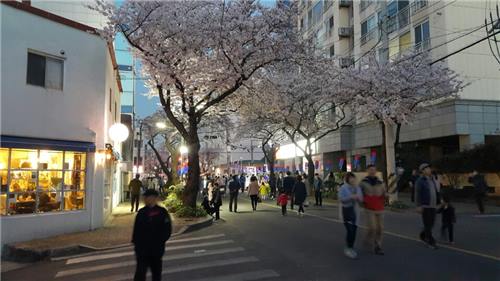ID :
402633
Tue, 04/05/2016 - 03:29
Auther :
Shortlink :
https://oananews.org//node/402633
The shortlink copeid
Indigenous cherry blossom finds its voice at home

By Chung Joo-won
JEJU, April 5 (Yonhap) -- For more than a century, the ancestry of cherry blossoms has been debated between Koreans and Japanese. The "chop down your cherry tree" movement that were waged in certain regions shortly after Korean independence in 1945 from the Japanese colonial rule would be among the most dramatic shows of such discord that ever took place on Korean soil.
But seven decades later, the cherry blossom has found its place in Korean mass culture and has become a graceful icon of spring.
For young generations, spring begins with selfies in front of fully bloomed cherry blossoms, while Busker Busker's "Cherry Blossom Ending" graces music charts and playlists. Limited spring editions of cherry blossom tumblers are neatly displayed in brand coffeehouses.
But it gets somewhat tricky when it comes to verbalizing the "reasons" for loving cherry blossoms.
"I think Korean cherry blossoms and Japanese ones are different. 'Japanese' cherry blossom is bad and 'Korean' cherry blossom is good, but I can't exactly put it in words," says Ahn Sung-young, a 58-year-old fortuneteller who flew from Seoul to enjoy the 25th Jeju Cherry Blossom Festival on Friday, held in Jeonnong-ro in Jeju City, 3 kilometers east of Jeju International Airport.
Young South Koreans and non-Asian tourists at the festival generally agree that cherry blossoms are a culture to enjoy, and not to resent.
"For the older generations, it would have been painful to be reminded what Japan did to Korea. But the newer generation could learn to embrace (cherry blossoms as part of its culture,)" says Julien Titar, a 24-year-old Frenchman who will earn his master's degree in business management in Ewha Woman's University in Seoul.
"Cherry blossom festivals could become something very beautiful and a way to reconcile (with Japanese people) in terms of history, and to start a new future. I would see cherry blossom festival rather as a new beginning than a tragic history."
However, cherry blossoms are not so complicated when it comes to the realm of science.
"Most cherry trees on the Korean Peninsula are indigenous, which originated from the wild cherry trees on Jeju Island," says Kim Chan-soo, a dendrologist and head of the subtropical forest research unit of the National Institute of Forest Science.
To forestry scientists like Kim, who has studied cherry trees all his life, it is strange to accuse Korea's indigenous tree of being "too Imperial Japanese." They say Cherry blossoms are something to study, not to hate.
Japan has not been as sensitive to the cherry blossom issue as here, but the controversy seems to have taken stronger hold over Japanese communities recently, he said.
As of now, there has not been joint research by Korean and Japanese scholars to shed light on the generic research of cherry trees.
"Cherry blossoms have been an essential part of Japanese culture. It may be a plant species for some people, but it can be a cherished culture of a people or a region. Hyper-sensitivity against (the historical context of cherry blossom) can incur a game of national pride, which is totally unnecessary.
"Cherry blossoms are but a beautiful creature -- You can't get enough of watching its beauty."
On this upcoming Friday, the subtropical forest researcher is slated to participate in the Cherry Blossom Symposium, hosted by the municipality of Jeju and organized by the National Institute of Forest Science. The dendrologist will introduce the culture and stories on indigenous cherry blossoms that are passed down from generation to generation in Jeju.
For Kim Seung-chul, a professor at Sungkyunkwan University and plant taxonomist, there has not been enough studies to identify the genetic origins of cherry blossoms in Jeju.
Plant taxonomy is a leg of life science that finds, identifies, describes, classifies, and names of plants.
"The origin of cherry blossoms has been contended for a long time, but only few of them led to actual cases of scientific research," he said.
The plant systematist Kim and dendrologist Kim are among the seven co-authors of the journal about the origin of the wild "Wangbut cherry tree," or an indigenous cherry tree that has thrived on Jeju Island and spread nationwide. The molecular and morphological analysis was published by the American Journal of Botany, one of the most prestigious journals on plant science, on Sept. 11, 2014.
"We started research on the journal in 2011 to find convincing account of the origin of Prunus yedoensis (Wangbut cherry tree). The discovery of the genetic origins of a plant species provides the crucial information necessary for their conservation and the development of diverse garden species."
The 48-year-old Korean scientist suggested that the scientific name of Wangbut cherry tree in Jeju, Prunus yedoensis, may have to be adjusted some day, because the name could be misleading about its origin. "Yedo" refers to Edo, or present-day Tokyo in Japan.
His team is currently engaged in another research project on the relationship between Japanese Prunus yedoensis and Korean Prunus yedoensis. The project is expected to conclude in a near future, according to the life scientist.
"As a basic scientist, I would like to share the new discoveries about the native species of Korea. In the cultural realm, the globalization of Korean cherry blossoms has become a valuable project in many Korean cultural institutions."
He said that he is sometimes asked, to his pleasure, to join the cherry blossom event where science and culture converge.
"Two days from now, at Sungkyunkwan University there will a tree-planting ceremony with a Wangbut cherry tree. I'm pleased to join the event -- Wangbut is a pure beauty."
jwc@yna.co.kr
(END)





